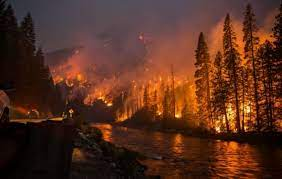Air pollution may be defined as, "the presence of one or more contaminants like dust, smoke, mist and odor in the atmosphere which are injurious to human brings, plants and animals".
Rapid industrialization, fast urbanization, rapid growth in population, drastic increase in vehicles on the roads and other activities of human beings have disturbed the balance of natural atmosphere.
Sources of Air Pollution :
Sources of Air Pollution are of two types
1. Natural Resources :
Examples - Volcanic eruptions, forest fires, biological decay, pollen grains, marshes, radioactive materials etc.
These pollutants are caused by Natural Resources.
2. Man-made Activities :
Examples - Thermal Power plants, vehicular emissions, fossil fuel burning, agricultural activities etc.,
Classification Of Air Pollutants :
Depending upon the form (origin) of pollutants present in the environment, they are classified as ,
i) Primary Air Pollutants.
ii) Secondary Air Pollutants.
1. Primary Air Pollutants.
Primary Air Pollutants are those emitted directly in the atmosphere in harmful form.
Example - CO, NO, SO2, etc.,
Indoor Air pollutants :
Indoor air pollutants are primary air pollutants. The most important indoor air pollutant is radon gas.
Sources Of Indoor Air Pollutants :
a). Radon gas is emitted from the building materials like bricks, concrete, tiles, etc., which are derived from soil containing radium.
b) It is also present in natural gas and ground water and is emitted indoors while using them.
c) Burning of fuels in the kitchen, cigarette smoke, liberates the pollutants like CO, So2, Formaldehyde, BAP (Benzo-(a)- pyrene)
2. Secondary Air Pollutants :
Some of the Primary air pollutants may react with one another or with the basic components of air to form new pollutants. They are called as secondary air pollutants.
Example - NO / No2 --------> (HNO3 / NO3) etc.,






Comments
Post a Comment